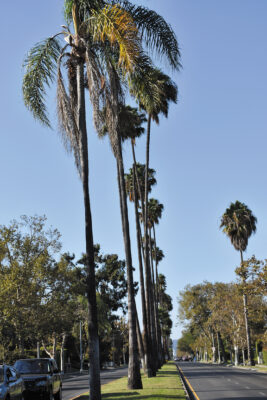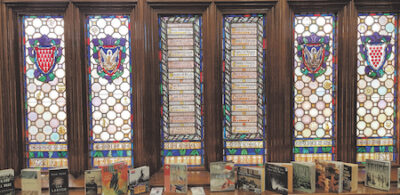City marks 60th year of preserving its many treasures
There have been many designation winners since the Los Angeles Cultural Heritage Ordinance was passed 60 years ago last month.
The Memorial Branch Library and its World War I-era stained glass windows and the tall majestic palms along Highland Avenue are among them.

TREES ON HIGHLAND were designated a Historic-Cultural Monument in 1972.
The elegant 1921 Ambassador Hotel did not survive the wrecking ball. But, while losing the hotel — where Robert F. Kennedy was fatally shot in 1968 — and its Cocoanut Grove nightclub was a setback, thankfully many other places have been saved, Ken Bernstein said on the eve of the anniversary.
As principal city planner, Bernstein heads the city’s Office of Historic Resources, while the Cultural Heritage Commission board designates the city’s Historic-Cultural Monuments (HCMs), which, as of last count, numbered 1,264.
Among the first places to be deemed historic under the pioneering ordinance was the Leonis Adobe built in 1844 in what is now Calabasas.
The ordinance was approved following a grassroots campaign to stop a shopping center from being built on the adobe site.
Also saved early on by the new ordinance — the first of its kind in a major urban center — was Angels Flight Railway, the 118-year-old funicular on Bunker Hill downtown.
Closer to home, the Wilshire Boulevard Temple, The Wiltern theater and La Casa de las Campanas, a treasured Spanish Colonial Revival home on North June Street, were all deemed historic.
The Ebell of Los Angeles was designated in 1982, and the El Royale Apartments on North Rossmore Avenue in 1986. The list also includes the Original Farmers Market and the El Rey Theatre.
Memorial Library
The stained-glass windows at Memorial Branch Library in Brookside were designed and built in 1930 by Judson Studios when the library was constructed. They were a gift to the library from the Los Angeles High School student body in honor of classmates who died in World War I.

STAINED GLASS window panels at Memorial Branch Library commemorate Los Angeles High School alumni who died in World War I.
While buildings make up the majority of sites saved by the ordinance, open spaces, including Griffith Park, and trees, such as those on Highland, have also been designated.
In 1928, residents and the city arranged to plant the palm trees along Highland between Wilshire Boulevard and Melrose Avenue and construct a median strip. The residents financed the project and, many years later, in 1972, the site was recognized as an Historic-Cultural Monument.
The designation grants properties a level of protection against demolition and has become more popular among homeowners, Bernstein said. Owners become eligible for preservation incentives such as the Mills Act Historical Property Contract Program, which can provide property tax relief.
Preservation also fosters more sustainable development and promotes repurposing of existing buildings while also combating climate change by recycling materials to reduce carbon emissions, city officials said.
The list of monuments ranges from modernist homes to Japanese florist shops and the cemetery of a pioneering Mexican family from California’s Rancho period.
“With influences from immigrant, migrant and indigenous communities, Los Angeles is an incredibly culturally rich city,’’ said Director of Planning Vince Bertoni. “Future Angelenos will be able to appreciate the efforts of previous generations as a result of our steadfast commitment to understanding the passion and enthusiasm upon which this great city was built.”
Learn more about the Leonis Adobe and other city historical sites at tinyurl.com/4t3fykaz.
Category: Real Estate
